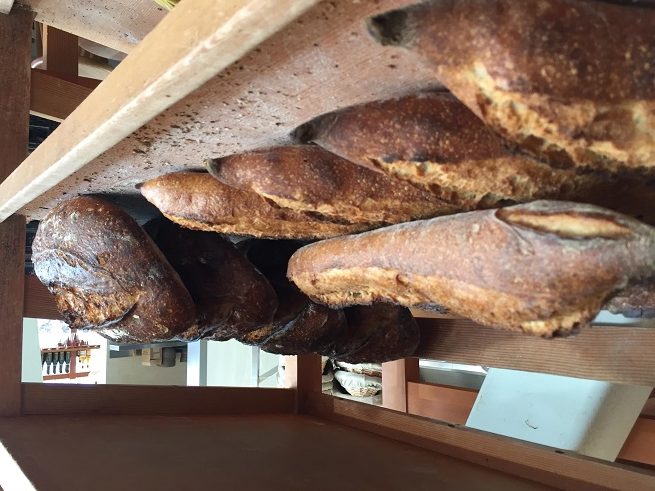Bread Legacy: San Francisco Sourdough and French Baguette
Local lactic acid bacteria fermenting in the dough starter is what makes San Francisco’s sourdough bread particularly sour. The French baguette uses the newer method of baker’s yeast for leavening which allowed creation of the elongated shape and silky texture of the iconic baguette. Both breads are very different, but they share a common legacy.
Sourdough starter was the way bread was made since the beginning of making bread. Early humankind found that if a blend of flour and water sat overnight, it formed bubbles. That was bacteria growing, and the end result was a fermenting or leavening agent that created a lighter, tastier bread than flatbreads. It had a slight sour taste, so historians have always called it sourdough.
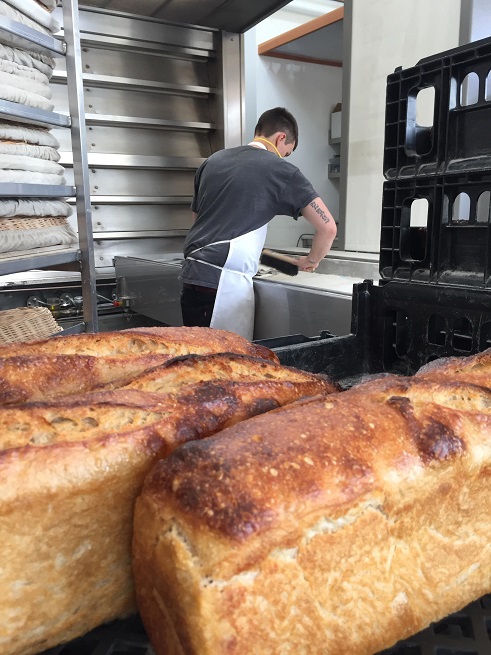
Baker at Tartine Manufactory cleans flour off baguette couches, which keep the bread’s shape intact and the surface dry.
Then came the 1850s. Two things happened connected to bread – the Gold Rush and germs. The California Gold Rush attracted French entrepreneurs to San Francisco. Although many became miners, many also brought their skills to the city and started businesses. Isidore Boudin started making bread in San Francisco in 1849 the same way she made it in France, but the bread tasted very sour. Actually, all the bread made in San Francisco tasted sour, although not as good as Boudin’s. The specific sour taste became so well known that miners in the California and Alaska Gold Rush that traveled with starter (often keeping it warm under their coats) became known as “sourdoughs.”
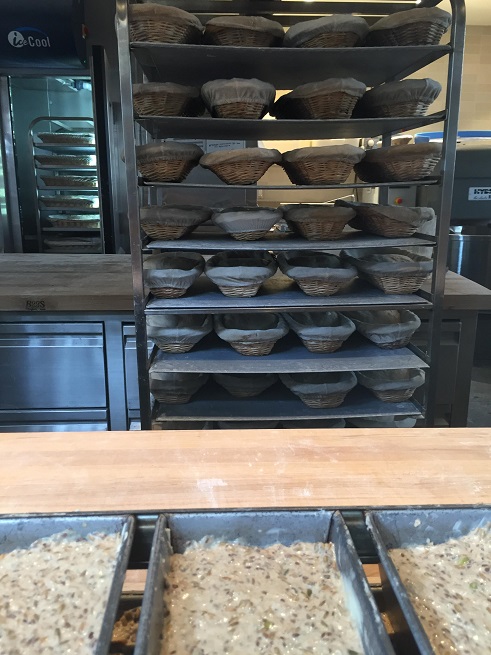
Dough rises in tin pans and baskets at Tartine Manufactory.
It was also when Louis Pasteur developed “germ theory” with the observation that microorganisms grew in fermentation, linking human diseases with the preparation of wine, milk and other foods. Like bread. This lead to the popularity of using brewer’s yeast (actually around since the 1830s) to make bread rise, and later baker’s yeast, eliminating the germ production process. The result was baguette – a sweeter, lighter bread that could be shaped differently than the standard boule, or round bread – which became popular in France.
According to Steven Laurence Kaplan in his book Good Bread is Back, it was just before World War II that yeast almost totally replaced sourdough as a bread starter in France. Kaplan quotes Raymond Geoffroy, a bread expert of the time: “Sourdough is a dead letter; its time is up; it is of no further use except in museums.”
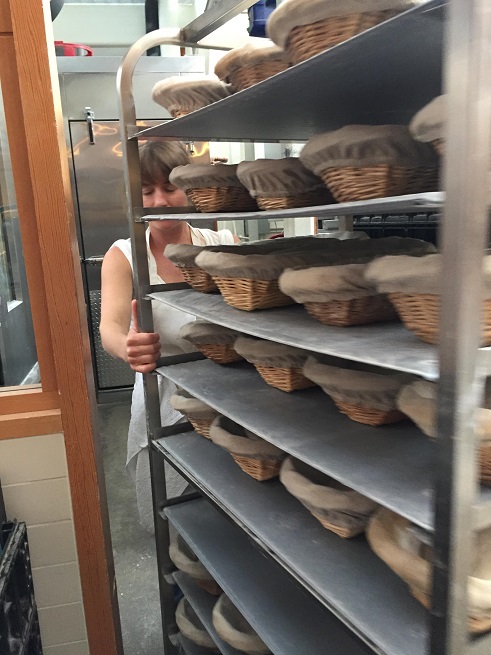
Dough is transported to the rising room, a temperature controlled area.
Except it was doing fine in San Francisco. Boudin and other bakeries were still making iconic sourdough bread. In fact, the special bacteria that gave San Francisco bread its sour flavor was given a special name – Lactobacillus sanfranciscensis. But the world was focused on another World War, along with the rebuilding of countries and cultures afterword. Good bread took a backseat.
According to Michael Kalanty, a San Francisco craft baker and author of How to Bake Bread, winner of the 2010 Gourmand International Award for Best Bread Book of the Year at the Paris Cookbook Fair, the character and quality of the French baguette decreased after World War II.
“Everyone wanted to make baguette faster using machines and forced heat to rise the bread,” he said. “Bread was required to last for days. It was even sold from vending machines.”
The result of the mechanization of bread was low quality in both France and San Francisco. Baguette was made in factories and trucked to stores and bakeries in France, sometimes taking a day or so for the delivery. In San Francisco and throughout the US, pre-sliced bread arrived on store shelves. That helped moms quickly make peanut butter/jelly or bologna sandwiches to pack in kids’ lunches but wasn’t great bread.
It was in the 1980s/90s that good bread began to make a comeback. Carol Field, a San Franciscan, published The Italian Baker in 1985 which introduced Americans to regional breads of Italy. The book not only won awards but also the hearts of chefs who realized that baking bread was an art they wanted to do.
“I was inspired by this book,” said Kalanty. “Baking is more like cooking than pastry. It’s alive. It’s interesting. The starter bubbles up and becomes something. There’s a fascination and exploration in being a bread chef.”
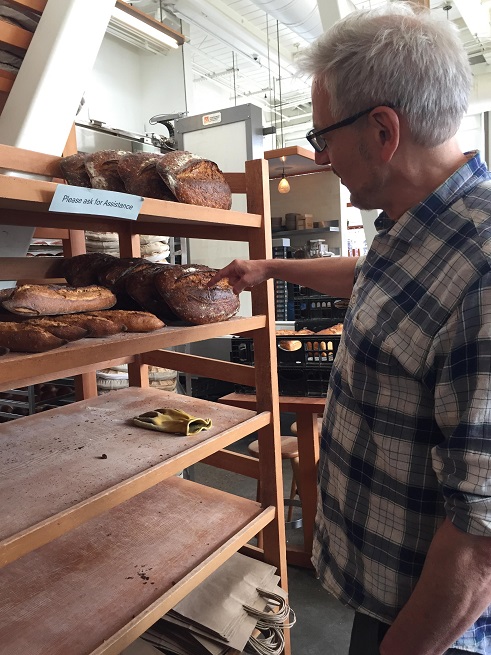
Mike Kalanty inspects the traditional boule (round bread) and baguette at Tartine Manufactory.
Many chefs in the San Francisco Bay Area were also inspired by making artisanal bread. They created low-volume, handmade loaves using a blend of old and new techniques and locally-sourced whole grain flours. One of the first bakeries was Acme Bread. Others like Semifreddi’s, Tartine Bakery, Della Fattoria and even Boudin (currently San Francisco’s oldest business) followed.
“These bakers slowed down the production process, and San Francisco’s bread history morphed into artisan bread,” said Kalanty. “Don’t call it sourdough, even though it was historically sour. The new breed of craft bakers have an interest in natural fermentation and wild yeast. Breads aren’t sour – they’re flavorful.”
There was a quality bread revolution in France too. In 1993, the Décret Pain law required that traditional baguettes must be made on the premises where they’re sold; consist of wheat flour, water, salt and yeast; can’t be frozen or contain additives or preservatives. To be called a Boulangerie, French bakers must make bread on the premises. They can then display a sign indicating “pain de tradition française“, “pain traditionnel français” or “pain traditionnel de France”.
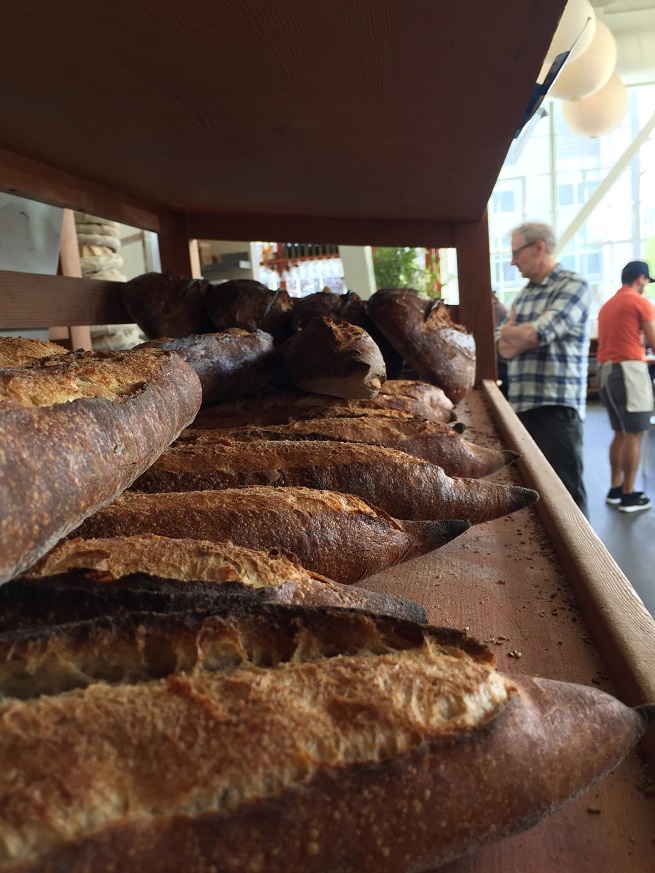
Bread and Mike Kalanty – a San Francisco team.
Being a boulanger, or baker, has also become respected as a craft position. Kalanty recently help host a “Bread Trek” throughout Paris with Epicurean Exchange and was impressed with the Campagnon apprenticeship system that teaches the skills of baking bread.
“This was the art, culture and history of bread, like a life course in French society” said Kalanty. “The beginning of this ethos is infused in these young bakers.”
To taste the traditional sourdough bread of San Francisco, Boudin has a store on Fisherman’s Wharf. Acme and other bakeries offering craft styles of bread can be found at the Ferry Building Marketplace on the Embarcadero and grocery stores around the city.
When in Paris, Kalanty suggests doing a baguette taste test. “Buy a warm baguette of tradition and an industrially made one. Smell them. The traditional one will smell of toasted almonds, pine nuts or walnuts. It will have fruity notes of raisons or dates, and also a caramel note, more crème brulee than butterscotch. Even the crusts will be different colors with the traditional one a richer brown. The industrial one will just smell like toast.”
Then cut the baguettes lengthwise. Look at the distribution of holes and size. The traditional will have irregular distribution of holes. If they are small and uniform, it’s the industrial one.
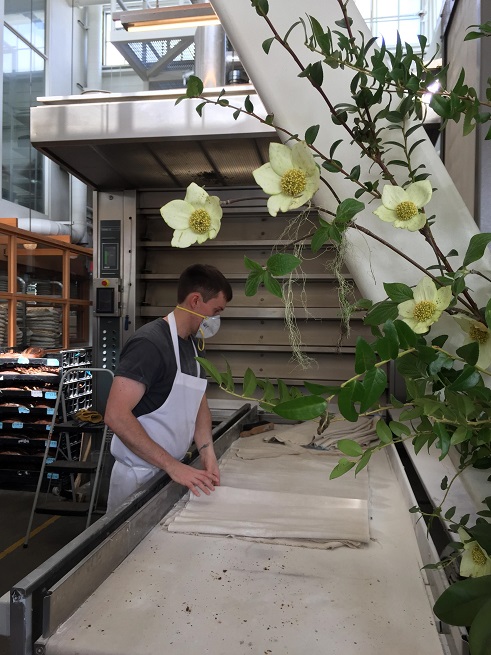
Baker readies the baguette couches at Tartine Manufactory.
“Run your thumb gently down the bread to see if the interior is silky, supple and moist,” said Kalanty. “If it’s like a drying out sponge, it’s machine dough.”
Now eat the baguettes. The traditional crust will crack with a sharpness and the interior will be tender and moist, like al dente pasta. This is called mie, and is a tender, but not too hard chew.
Miam! No wonder boulangers are called craft bakers.
A list of Mike Kalanty’s “most honorable boulangeries in Paris”:
- Dominique Sabron, located in Paris 75014
- L’étoile du Berger, located in Sceaux
- Boulangerie Pichard, located in Paris 75015
- Delmontel, located in Paris 75004
- Maison Landemaine, located in Paris 75004
Share to: Facebook Twitter LinkedIn Email
Leave a reply
Your email address will not be published. Required fields are marked *

